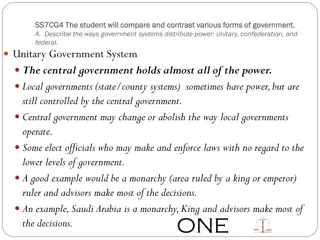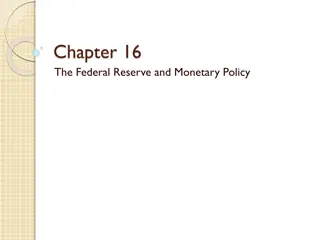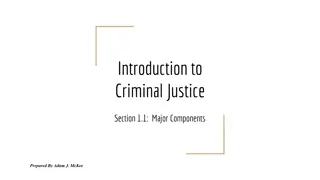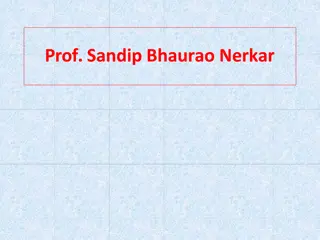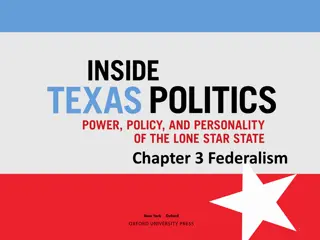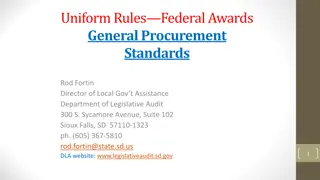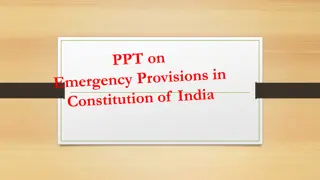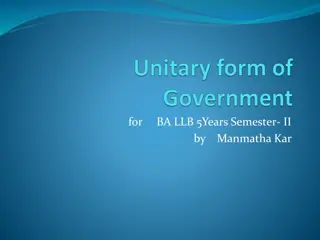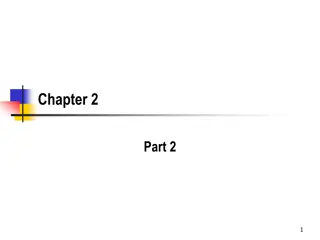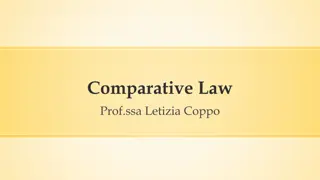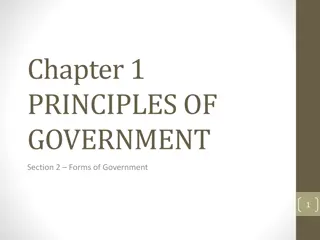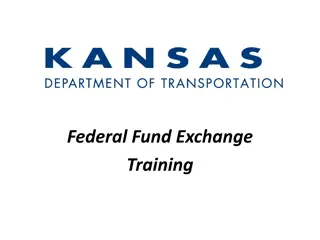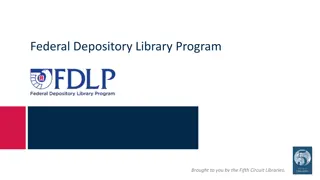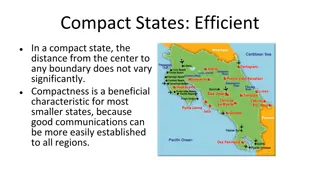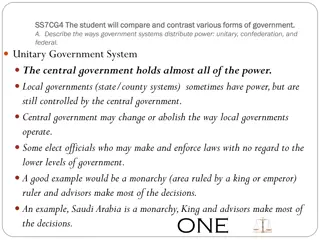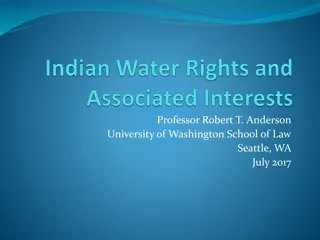Overview of Unitary, Confederal, and Federal States
Unitary, confederal, and federal states each have distinct characteristics regarding the distribution of power between central and subnational governments. Unitary states have centralized governance, while devolved states like the UK grant autonomy to subnational entities. Decentralized states transfer authority to regional governments. Confederations involve independent states collaborating for common goals, and federal states like the USA divide sovereignty between central and subnational levels. American federalism exemplifies this structure with its 50 states.
Download Presentation

Please find below an Image/Link to download the presentation.
The content on the website is provided AS IS for your information and personal use only. It may not be sold, licensed, or shared on other websites without obtaining consent from the author. Download presentation by click this link. If you encounter any issues during the download, it is possible that the publisher has removed the file from their server.
E N D
Presentation Transcript
Types Unitary Confederal Federal
Unitary state A unitary state is a state governed as one single unit in which the central government is the decision centre. Subnational and local governments exercise only the power that the central governments choose to delegate. The UK and Croatia
A devolved state A devolved state is a centralized state such as the United Kingdom, where subnational governments have a degree of autonomous power devolved from the central government. A devolved government cannot challenge the constitutionality of central government's law. The power given by the central government can be revoked, or reduced. For example, the Northern Ireland Assembly has been suspended many times by London since its creation. In theory, decentralized and devolved states are different, but in practice the differences are very thin.
A decentralized state A decentralized state is generally a former unitary state. The authority and responsibility for some public functions have been transferred from the central government to the regional government.
Confederal state Confederations are voluntary associations of independent states that, to secure some common purpose, agree to certain limitations on their freedom of action and establish some joint machinery of consultation or deliberation. A confederation (also known as a confederacy or league) is a union of sovereign states, united for purposes of common action often in relation to other states. Germany
A federal state A federal state is a type of sovereign state in which sovereignty is constitutionally divided between a central government and the subnational governments. USA
American federalism The United States of America is a federal republic composed of 50 states The former British colonies (13) broke with Great Britain in 1776 and were recognized as a new nation following the Treaty of Paris in 1783 During the 19th and 20th centuries 37 new states were added to the original 13
The Declaration of Independence In 1776 there were 13 weak British colonies in America (Virginia, Delaware, Pennsylvania, New Jersey, New York, Georgia, Connecticut, Massachusetts, Maryland, South Carolina, North Carolina New Hampshire, Rhode Island) The Declaration of Independence, 1776 We hold these truths to be self-evident, that all men are created equal, that they are endowed by their Creator with certain unalienable rights, that among these are Life, Liberty and the pursuit of Happiness. Mainly written by Thomas Jefferson American colonists acted to win rights they felt had been denied them as English subjects
The US Constitution The oldest Constitution still in force (written in 1787, came into force in 1789) To date there have been 27 amendments Sets the basic form of government: three separate branches, each one having powers ( checks and balances ) over the others Specifies the powers and duties of each federal branch of government Guarantees basic rights for the citizens The ultimate power is given to the people
Preamble We the people of the United States, in order to form a more perfect Union, establish justice, insure domestic tranquility, provide for the common defense, promote the general welfare, and secure the blessings of liberty to ourselves and our posterity, do ordain and establish this Constitution for the United States of America.
The Bill of Rights The first ten Constitutional Amendments Fundamental rights of any American The freedom of religion, speech, press, the rights of peaceful assembly, the right of trial by jury These rights cannot be taken away by any government or court https://www.youtube.com/watch?v=IQNiBQehwp8
Federalism A form of political organization in which the exercise of power is divided between two levels of government: the nation and the states Exclusively national powers: determining foreign policy (declaring wars, making treaties, controlling imports and exports); protecting a uniform monetary system - control of the power to coin money
Checks and balances The Constitution s Framers set out a government in which no person or branch of government could become all-powerful They divided the powers among lawmakers, judges and a chief executive Each group can balance and check other s powers
Complexity of the modern state Since the 20th century, the continuing and intensified expansion of state rule has resulted in the tendency of the administrative apparatus to grow in size and complexity. Economicglobalization - a process whereby state functions are transferred to markets. The EU
Fill in the missing forms where applicable: NOUN (concept) NOUN (person) VERB ADJECTIVE administration apply bureaucracy delegate direct execute govern legislate perform
Explain the main functions of the state and include the relevant institutions: FUNCTION EXPLANATION INSTITUTION legislative executive judicial
Match the terms from the text with their definitions: TERM DEFINITION 1. Cabinet a. The system by which a state or community is governed 2. court b. A body convened to hear a dispute 3. delegated legislation c. The maximal achievement of goals 3. effectiveness d. The optimal relation between means and ends 4. efficiency e. Subordinate legislation, mostly governmental 5. government f. A body of ministers consisting mostly of heads of chief government departments, headed by the Prime Minister g. A body established by law for the administration of justice 6. tribunal
Fill in the missing elements in the following collocations from the text: 1. ___________________disputes. 2. __________________the legislative function. 3. __________________laws. 4. __________________operation. 5. __________________the power. 6. __________________the required standards.
Translate into Croatian: Today, however, we have to say that a state is a human community that (successfully) claims the monopoly of the legitimate use of physical force within a given territory. Note that 'territory' is one of the characteristics of the state. Specifically, at the present time, the right to use physical force is ascribed to other institutions or to individuals only to the extent to which the state permits it. The state is considered the sole source of the 'right' to use violence. Hence, 'politics' for us means striving to share power or striving to influence the distribution of power, either among states or among groups within a state.


